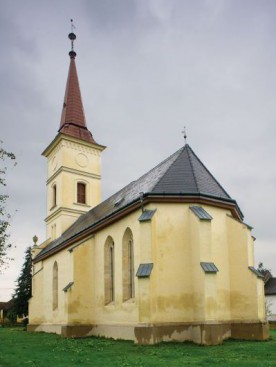Calvinist church in TúristvándiThe church of Túristvándi was built in the second half of the 1470s. As the village belonged to the Kölcsey and Kende families, it is probable that its church was built by them. However, smaller or bigger parts of estates belonging to the Perényis and the Báthorys could also be found here from the 16th century. It is probable that the church of Kölcse was built together by the Kölcseys and the Kendes in the first half of 14th century, which was the most significant church of the Kölcsey family. The Kölcseys could also be found in the possession of the present Tiszakóród, Túristvándi and Nagyszekeres, in conclusion, it is probable that they played a role in the building of the churches located there. The church of Túristvándi was the burial place of the Kölcsey and the Kende families for centuries. The members of the Kende and the Kölcsey families started to distinguish the two families at the end of the 14th century, and in 1515 the Kende family also distinguished into two branches, the Kende family of Kölcse and Cégény. The Kende families were loyal to their principles and to their Calvinist religion, which they picked up in the 16th century, so they could be found as patrons of several churches. Between the members of the generation many poets, writers, politicians and scientist served the raising of the nation as liberal, conservative politicians, priests, teachers, soldiers, farmers and as clerks. One of their most impressive relics is the Kölcsey-Kende mansion, which was built on the bank of the river Szamos, in 1833 by Zsigmond Kende baron. The church of Túristvándi was built in Gothic style. To the square-based nave of the church, an irregular octagon-based sanctuary is attached from the east. In the past, the church featured a square-based vestry on the northern side of the sanctuary, which was demolished when the Reformation forged ahead. On the northern wall of the sanctuary, the shoulder of the wagon vault of the vestry and the beam nests of its capriata, a small-sized square-based almery, and the opening of the Gothic door linking the vestry with the sanctuary have also been found. The most typical characteristic feature of Gothic architecture is pointed arches. They were frequently used for openings, as in Túristvándi, for instance, for the gate of the tower, for the windows of the sanctuary and the nave, and also for the triumphal arch dividing the two sections of the space. The widespread use of pointed arches in Europe may have had symbolic factors: in church architecture, perhaps, their fundamental forms directing upwards - that is, to heaven. However, the pointed arches also had some disadvantages that the constructors needed to compensate, especially in the case of vaults. Due to the fact that the structures featuring pointed arches had an increased volume, and accordingly, the pressure was larger, it was almost always necessary for them to be buttressed. As a result, the buttresses became fundamental elements of Gothic architecture, and their aesthetic role also became significant. It is not by accident that the style is still identified by this structure in addition to the pointed arches. As it was almost compulsory in the case of medieval churches, the two sections of the space in the church of Túristvándi, the sanctuary and the nave, are divided by a so-called triumphal arch. Visually, it also indicates the borderline between the place reserved for the clergy performing the service - that is, the sanctuary, and the place for the believers to be used - that is, the nave. At the meeting points of these two sections, on the inner side of the arch, a square-based carved hole can be found. The holes do not really have a connection with the construction of the arch, as it is thought to be many times. These beams had a connection with the furnishings of the church. Primarily, a wooden sculpture or wood sculptures were placed on them. In Medieval times, their forms of depiction were prescribed, in each of the cases, the Crucifixion was illustrated. The original Latin name of the genre is “crux triumphalis” - that is, “triumphal cross”, which refers to Christ's victory on the cross. According to their placement, they are called “triumphal arch crosses” in the Hungarian language. In 1770, the church was damaged by a devastating fire. Eight years were required to restore the church, which was almost completely burned down. The ceiling of the church was converted to cassette-style at that period of time. In the past, the church featured a belfry. In 1858, it was sold to the people of Nemesborzova, and later, it was taken to the Village Museum of Szentendre. The present stone tower was built from 1858 to 1876 with great financial and human effort. The relative wealth of Istvándi was due to the river Túr and the water mill on it belonging to the village. Due to the continuous graining, the village became the target of the people living in the surroundings, and became the small “center” of the area. Their relative wealth was also preserved in their oral traditions. It was believed by the elderly that the silver bell in the bell tower, which rang at noon, and which invited people to the service, originated from 1595. According to tradition, this bell was sold in 1787 in order to cover the expenses of the restoration being implemented at that time. According to another tradition, the silver bell was buried in the surroundings of the church at the time of the Rákóczi’s War of Independence. The bigger one of the two existing bells is from 1869, the smaller one from 1923. |























